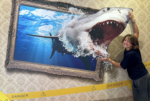Animali Sacri
.jpg)
Per concludere la stagione 2015/2016, Nero Gallery è lieta di presentare la mostra collettiva Animali Sacri.
Comunicato stampa
ANIMALI SACRI
Mostra collettiva a cura di Giulia Capogna e Daphnée Thibaud.
J.A.W. Cooper – Twee Muizen - Beatriz Mutelet –Corine Perier – Selena Leardini
Inaugurazione 28 maggio 2016 ore 20.00 | Nero Gallery – Roma
Finissage 30 luglio 2016 ore 20.00
www.nerogallery.com | FB/nerogallery
Per concludere la stagione 2015/2016, Nero Gallery è lieta di presentare la mostra collettiva Animali Sacri. La galleria ha il grande onore di ospitare per la prima volta in Italia l’artista americana J.A.W Cooper, affiancata, da altrettanto notevoli artisti: la coppia spagnola Twee Muizen, le due francesi Beatriz Mutelet e Corine Perier e l’italiana Selena Leardini.
Per Animali Sacri abbiamo chiesto agli artisti di rappresentare l’animale nella loro dimensione sacrale. La mostra mette al centro i profondi legami esistenti tra le grandi religioni e tutte le forme viventi, ma anche, talvolta, il rapporto complesso e contraddittorio.
Tante sono le religioni, dalla preistoria ad oggi, ad aver costruito gran parte dei loro culti sulla venerazione degli animali: le tradizioni sciamaniche, il cristianesimo celtico, la religione egizia, il buddismo, l’induismo… fino alle tre principali religioni monoteiste: l’islam, il cattolicesimo, l’ebraismo.
J.A.W Cooper ci offre, nel suo trittico, la rappresentazione del legame tribale e ancestrale tra l’animale e l’uomo. In ogni disegno la figura umana è affiancata da una fiera che né simboleggia un tratto particolare: il leone e i pesci sono allegorie di forza e fecondità, la tigre ha una doppia faccia, da una parte di giustizia e successo e, dall’altra di distruzione, infine, l’ibis descrive il destino.
Beatriz Mutelet ha scelto d’indagare il culto degli animali nella religione egizia, reinterpretando le divinità zoomorfe: Bastet, Horus, Tefnout. Corine Perier sceglie, invece, di rappresentare l’animale nei suoi tratti più ibridi in una veste preziosa e rara, rendendoli umani e onorando la loro bellezza.
Le religioni asiatiche sono interpretate dal duo dei Twee Muizen. Il pavone che rappresenta l’animale sacro indiano e l’unicorno venerato in Cina. Nelle loro opere questi due animali sono simboli di saggezza e bellezza. L’artista italiana Selena Leardini esplora questo universo attraverso un esegesi dei santi cristiani e delle sue simbologie, come per esempio l’agnello in una chiave più onirica e surreale.
Nella religione cristiana e, soprattutto, durante il medioevo, la figura dell’animale era vista come inferiore e sottomessa all’uomo. Col passare del tempo, però, si ritorna al legame che il cristianesimo voleva far sparire dalle religioni pagane, l’animale diventa simbolo del bene, aiuta l’uomo a interpretare il mondo, e ha anche uno scopo moralizzatore. L’animale è considerato una creatura di Dio al pari dell’uomo e quindi allo stesso livello. «L’uomo può e deve amare le creature di Dio. Da Dio le riceve e le guarda e le onora come se al presente uscissero dalle mani di Dio».
SACRED ANIMALS
Collective show curated by Giulia Capogna and Daphnée Thibaud.
J.A.W. Cooper – Twee Muizen - Beatriz Mutelet –Corine Perier – Selena Leardini
Opening 28th May 2016 h. 8.00 pm. | Nero Gallery – Roma
Closing 30th July 2016 h. 8.00 pm.
www.nerogallery.com | FB/nerogallery
To end the 2015/2016 season, Nero Gallery is pleased to present the group exhibition Sacred Animals.
We have the great honor of hosting for the first time in Italy the American artist J.A.W Cooper, flanked by equally remarkable artists: the Spanish couple Twee Muizen, the two French Beatriz Mutelet and Corine Perier and Italian Selena Leardini.
For Sacred Animals we asked the artists to represent the animal in their sacred dimension.
The exhibition focuses on the deep ties existing between the major religions and all forms of life but also, sometimes, their complex and contradictory relationship.
From prehistory to the present, many religions have built much of their cults on animal veneration: the shamanic traditions, Celtic Christianity, the Egyptian religion, Buddhism, Hinduism ... until the three major monotheistic religions: l 'Islam, Catholicism, Judaism.
J.A.W Cooper offers us, as a triptych, the representation of tribal and ancestral link between animal and man.
In each drawing the human figure is accompanied by an exhibition that symbolizes a particular trait: the lion and the fish are allegories of strength and fertility, the tiger has a double-sided, one side of righteousness and success and, on the other of destruction, finally, describes the fate ibis.
Beatriz Mutelet chooses to investigate the cult of animals in the Egyptian religion, by reinterpreting the zoomorphic deity Bastet, Horus, Tefnut.
Corine Perier, instead, chooses to represent animals in their most hybrid traits in a precious and rare robe, trying to honor their beauty by making them humans.
The asian religions are interpreted by the Twee Muizen duo, the peacock, which is the Indian sacred animal and the Unicorn revered in China. These two animals symbolize wisdom and beauty in their works.
The Italian artist Selena Leardini explores this universe through an exegesis of Christian saints and its symbols such as the lamb, in a key more dreamlike and surreal.
In the Christian religion, and especially during the Middle Age, the animals were conceptualized as inferior and subservient to man. As time passed, however, since Christianity wanted to get rid of the pagan religions, the animal became positive symbol, which helped man to interpret the world. Further, it also had a moralizing meaning. The animal was considered a creature of God, like man, thus at the same level. “Man can and must love the creatures of God. From God receives them; then looks and honors them, as if they come from God's hands.”



